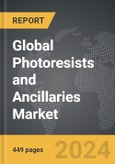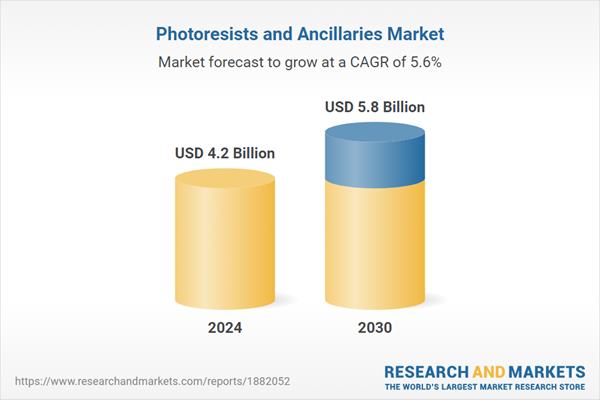The global market for Photoresists and Ancillaries was valued at US$4.2 Billion in 2024 and is projected to reach US$5.8 Billion by 2030, growing at a CAGR of 5.6% from 2024 to 2030. This comprehensive report provides an in-depth analysis of market trends, drivers, and forecasts, helping you make informed business decisions. The report includes the most recent global tariff developments and how they impact the Photoresists and Ancillaries market.
Recent trends in the photoresists and ancillaries market highlight the push towards advanced semiconductor nodes and the need for high-resolution patterning. As the demand for smaller, faster, and more power-efficient electronic devices grows, the semiconductor industry is moving towards manufacturing processes at sub-10nm scales. This miniaturization requires photoresists with higher sensitivity and resolution capabilities. Extreme Ultraviolet (EUV) lithography is becoming increasingly important in this context, as it allows for finer patterning compared to traditional deep ultraviolet (DUV) lithography. The development of EUV-specific photoresists and corresponding ancillaries is a significant focus for researchers and manufacturers. Additionally, innovations in materials science are leading to the creation of novel photoresist formulations that can better withstand the aggressive etching processes and offer improved performance for next-generation semiconductor devices.
The growth in the photoresists and ancillaries market is driven by several factors. Firstly, the rapid advancement in semiconductor technology, particularly the shift towards EUV lithography, is creating a high demand for advanced photoresist materials that can achieve the necessary resolution and sensitivity for cutting-edge applications. Secondly, the proliferation of consumer electronics, such as smartphones, tablets, and wearable devices, is fueling the demand for smaller and more efficient semiconductor components, thereby increasing the need for high-performance photolithography materials. Thirdly, the automotive industry’s growing reliance on semiconductor technology for advanced driver-assistance systems (ADAS), electric vehicles (EVs), and autonomous driving technologies is further propelling market growth. Additionally, the rise of the Internet of Things (IoT) and the increasing deployment of 5G networks are driving the need for more sophisticated and densely packed semiconductor devices. These technological advancements and the expanding applications of semiconductors across various industries are collectively driving the robust growth of the photoresists and ancillaries market, highlighting its critical role in the ongoing evolution of modern technology.
Segments: Type (G-line, ArF Immersion Photoresist, KrF Photoresist, ArF Dry Photoresist, I-line Photoresist); Application (Semiconductors & ICs, Printed Circuit Boards, LCDs, Other Applications).
Geographic Regions/Countries: World; United States; Canada; Japan; China; Europe (France; Germany; Italy; United Kingdom; Spain; Russia; and Rest of Europe); Asia-Pacific (Australia; India; South Korea; and Rest of Asia-Pacific); Latin America (Argentina; Brazil; Mexico; and Rest of Latin America); Middle East (Iran; Israel; Saudi Arabia; United Arab Emirates; and Rest of Middle East); and Africa.
The analysts continuously track trade developments worldwide, drawing insights from leading global economists and over 200 industry and policy institutions, including think tanks, trade organizations, and national economic advisory bodies. This intelligence is integrated into forecasting models to provide timely, data-driven analysis of emerging risks and opportunities.
Photoresists and Ancillaries - Key Trends and Drivers
Photoresists and ancillaries are crucial materials used in the photolithography process for semiconductor manufacturing and other microfabrication applications. Photoresists are light-sensitive materials that form patterns on a substrate when exposed to ultraviolet (UV) light, enabling the etching of intricate designs onto semiconductor wafers. These patterns serve as templates for building the complex circuitry found in integrated circuits and microelectromechanical systems (MEMS). There are two main types of photoresists: positive and negative. Positive photoresists become soluble when exposed to UV light, allowing the exposed regions to be washed away, whereas negative photoresists become insoluble, leaving the exposed regions intact. Ancillaries, which include developers, edge bead removers, adhesion promoters, and anti-reflective coatings, support the photoresist process by enhancing adhesion, improving resolution, and ensuring accurate pattern transfer.Recent trends in the photoresists and ancillaries market highlight the push towards advanced semiconductor nodes and the need for high-resolution patterning. As the demand for smaller, faster, and more power-efficient electronic devices grows, the semiconductor industry is moving towards manufacturing processes at sub-10nm scales. This miniaturization requires photoresists with higher sensitivity and resolution capabilities. Extreme Ultraviolet (EUV) lithography is becoming increasingly important in this context, as it allows for finer patterning compared to traditional deep ultraviolet (DUV) lithography. The development of EUV-specific photoresists and corresponding ancillaries is a significant focus for researchers and manufacturers. Additionally, innovations in materials science are leading to the creation of novel photoresist formulations that can better withstand the aggressive etching processes and offer improved performance for next-generation semiconductor devices.
The growth in the photoresists and ancillaries market is driven by several factors. Firstly, the rapid advancement in semiconductor technology, particularly the shift towards EUV lithography, is creating a high demand for advanced photoresist materials that can achieve the necessary resolution and sensitivity for cutting-edge applications. Secondly, the proliferation of consumer electronics, such as smartphones, tablets, and wearable devices, is fueling the demand for smaller and more efficient semiconductor components, thereby increasing the need for high-performance photolithography materials. Thirdly, the automotive industry’s growing reliance on semiconductor technology for advanced driver-assistance systems (ADAS), electric vehicles (EVs), and autonomous driving technologies is further propelling market growth. Additionally, the rise of the Internet of Things (IoT) and the increasing deployment of 5G networks are driving the need for more sophisticated and densely packed semiconductor devices. These technological advancements and the expanding applications of semiconductors across various industries are collectively driving the robust growth of the photoresists and ancillaries market, highlighting its critical role in the ongoing evolution of modern technology.
Report Scope
The report analyzes the Photoresists and Ancillaries market, presented in terms of units. The analysis covers the key segments and geographic regions outlined below.Segments: Type (G-line, ArF Immersion Photoresist, KrF Photoresist, ArF Dry Photoresist, I-line Photoresist); Application (Semiconductors & ICs, Printed Circuit Boards, LCDs, Other Applications).
Geographic Regions/Countries: World; United States; Canada; Japan; China; Europe (France; Germany; Italy; United Kingdom; Spain; Russia; and Rest of Europe); Asia-Pacific (Australia; India; South Korea; and Rest of Asia-Pacific); Latin America (Argentina; Brazil; Mexico; and Rest of Latin America); Middle East (Iran; Israel; Saudi Arabia; United Arab Emirates; and Rest of Middle East); and Africa.
Key Insights:
- Market Growth: Understand the significant growth trajectory of the G-line segment, which is expected to reach US$2.5 Billion by 2030 with a CAGR of a 6.3%. The ArF Immersion Photoresist segment is also set to grow at 5.7% CAGR over the analysis period.
- Regional Analysis: Gain insights into the U.S. market, valued at $1.1 Billion in 2024, and China, forecasted to grow at an impressive 8.7% CAGR to reach $1.3 Billion by 2030. Discover growth trends in other key regions, including Japan, Canada, Germany, and the Asia-Pacific.
Why You Should Buy This Report:
- Detailed Market Analysis: Access a thorough analysis of the Global Photoresists and Ancillaries Market, covering all major geographic regions and market segments.
- Competitive Insights: Get an overview of the competitive landscape, including the market presence of major players across different geographies.
- Future Trends and Drivers: Understand the key trends and drivers shaping the future of the Global Photoresists and Ancillaries Market.
- Actionable Insights: Benefit from actionable insights that can help you identify new revenue opportunities and make strategic business decisions.
Key Questions Answered:
- How is the Global Photoresists and Ancillaries Market expected to evolve by 2030?
- What are the main drivers and restraints affecting the market?
- Which market segments will grow the most over the forecast period?
- How will market shares for different regions and segments change by 2030?
- Who are the leading players in the market, and what are their prospects?
Report Features:
- Comprehensive Market Data: Independent analysis of annual sales and market forecasts in US$ Million from 2024 to 2030.
- In-Depth Regional Analysis: Detailed insights into key markets, including the U.S., China, Japan, Canada, Europe, Asia-Pacific, Latin America, Middle East, and Africa.
- Company Profiles: Coverage of players such as ALLRESIST GmbH, Avantor, Inc., Dow Inc., E. I. du Pont De Nemours and Company, Fujifilm Electronic Materials U.S.A., Inc. and more.
- Complimentary Updates: Receive free report updates for one year to keep you informed of the latest market developments.
Some of the 12 companies featured in this Photoresists and Ancillaries market report include:
- ALLRESIST GmbH
- Avantor, Inc.
- Dow Inc.
- E. I. du Pont De Nemours and Company
- Fujifilm Electronic Materials U.S.A., Inc.
- JSR Corporation
- Microchemicals GmbH
- Shin-Etsu Chemical Co., Ltd.
- Sumitomo Chemical Co., Ltd.
- Tokyo Ohka Kogyo Co., Ltd.
Tariff Impact Analysis: Key Insights for 2025
Global tariff negotiations across 180+ countries are reshaping supply chains, costs, and competitiveness. This report reflects the latest developments as of April 2025 and incorporates forward-looking insights into the market outlook.The analysts continuously track trade developments worldwide, drawing insights from leading global economists and over 200 industry and policy institutions, including think tanks, trade organizations, and national economic advisory bodies. This intelligence is integrated into forecasting models to provide timely, data-driven analysis of emerging risks and opportunities.
What’s Included in This Edition:
- Tariff-adjusted market forecasts by region and segment
- Analysis of cost and supply chain implications by sourcing and trade exposure
- Strategic insights into geographic shifts
Buyers receive a free July 2025 update with:
- Finalized tariff impacts and new trade agreement effects
- Updated projections reflecting global sourcing and cost shifts
- Expanded country-specific coverage across the industry
Table of Contents
I. METHODOLOGYII. EXECUTIVE SUMMARY2. FOCUS ON SELECT PLAYERSIII. MARKET ANALYSISCANADAITALYSPAINRUSSIAREST OF EUROPESOUTH KOREAREST OF ASIA-PACIFICARGENTINABRAZILMEXICOREST OF LATIN AMERICAIRANISRAELSAUDI ARABIAUNITED ARAB EMIRATESREST OF MIDDLE EASTIV. COMPETITION
1. MARKET OVERVIEW
3. MARKET TRENDS & DRIVERS
4. GLOBAL MARKET PERSPECTIVE
UNITED STATES
JAPAN
CHINA
EUROPE
FRANCE
GERMANY
UNITED KINGDOM
ASIA-PACIFIC
AUSTRALIA
INDIA
LATIN AMERICA
MIDDLE EAST
AFRICA
Companies Mentioned (Partial List)
A selection of companies mentioned in this report includes, but is not limited to:
- ALLRESIST GmbH
- Avantor, Inc.
- Dow Inc.
- E. I. du Pont De Nemours and Company
- Fujifilm Electronic Materials U.S.A., Inc.
- JSR Corporation
- Microchemicals GmbH
- Shin-Etsu Chemical Co., Ltd.
- Sumitomo Chemical Co., Ltd.
- Tokyo Ohka Kogyo Co., Ltd.
Table Information
| Report Attribute | Details |
|---|---|
| No. of Pages | 449 |
| Published | April 2025 |
| Forecast Period | 2024 - 2030 |
| Estimated Market Value ( USD | $ 4.2 Billion |
| Forecasted Market Value ( USD | $ 5.8 Billion |
| Compound Annual Growth Rate | 5.6% |
| Regions Covered | Global |






